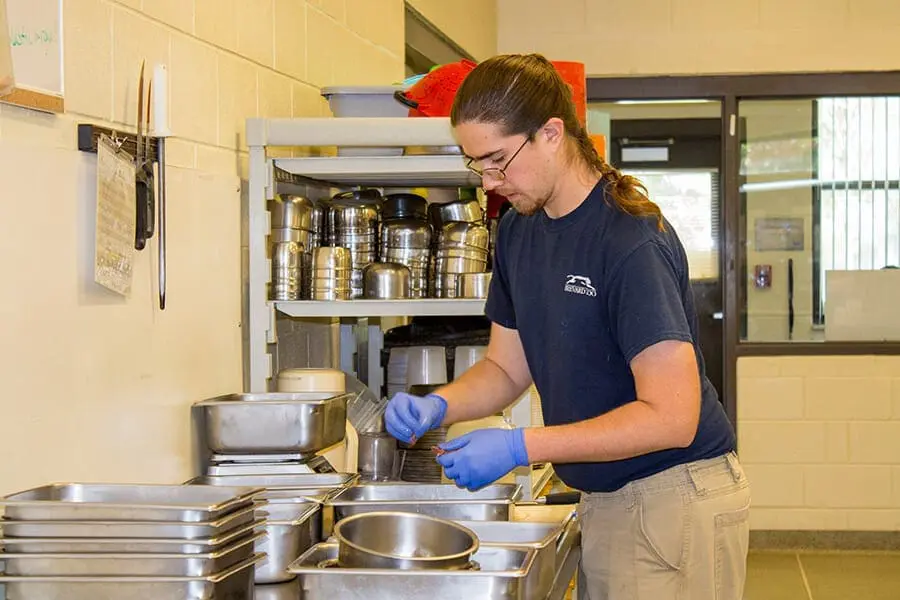

Peter puts the finishing touches on a carnivore meal.
Every morning at 5:30, before the sun comes up and the Zoo is still sleepy, the first workers head to the back corner of the Zoo to start their shift in the commissary. Food prep is an extremely detailed job, from checking animal meal schedules to weighing out exact measurements of vegetables, pellets, insects and meat. Every species has an individualized diet to meet its unique nutritional needs, carefully researched and designed by our commissary manager, veterinarian and keepers. Staff continue to “cook” and clean until 7:30 p.m., staying later than almost every other employee.
The team is led by commissary manager Matt Quavillon, who has a culinary degree, is a certified dietary manager and has experience studying animal nutrition management at the National Zoo in Washington, D.C. Other staff include diet specialists Peter and Carly, as well as several volunteers who love ensuring our animals never go hungry! Though the work is strict and precise, it hasn’t stopped these foodies from finding ways to get creative and make eating more fun for the animals. The diet specialists have an ongoing competition—who can make the best birthday “cake”? Volunteers get in on the fun, too, by creating enrichment items to hide food in, encouraging the animals to “hunt” for delicious treats! These creations have included papier-mâché balls packed with birdseed and insects left in hole-filled boxes for our reptiles.

A fruit-based enrichment item artfully prepared for the macaws.
So how much food does it take to feed all our residents? According to Matt, that’s a tricky question to answer. The numbers vary based on individual diets and what species we have in the Zoo, with availability of food varying seasonally. Most animals eat a type of “pellet” as a baseline nutritional item, filled with a special blend of nutrients and vitamins. Each week, we spend an average of $1,800 on produce; vegetables are the most in-demand items. Mealworms are bred in the commissary, but we regularly receive orders of insects and rodents, including crickets and frozen mice and rats. It takes about 24,000 pounds of meat each year to feed our carnivores and omnivores, which is enriched with supplements for animals in human care. Even our rehabilitation patients in the Sea Turtle Healing Center require custom seafood diets, which are prepared by our dedicated team of sea turtle volunteers. It may be tons of food, literally, but we never have a problem with waste—every bit of it gets used as meals, enrichment items or treats for training sessions!
The goal is to provide our residents with the best nutrition possible. “It’s definitely a team effort. There’s no way I can take all the credit—we have an amazing staff and so many volunteers who bring creative ideas to our recipes,” says Matt. You may not see our commissary staff out and about, but whenever you spot your favorite animals chowing down, know it was prepared in our state-of-the-art kitchen in the back corner of the Zoo.

A coati sniffing out his omelet!
If you’re interested in trying one of the coatis’ favorite meals, check out this simple, four-ingredient recipe:
Green Pepper and Carrot Omelet
- 2 eggs
- 1/8 cup shredded carrot
- 1/8 cup shredded green pepper
- Finely chopped kale
Beat the eggs and put into non-stick pan over medium heat. Add fresh ingredients and close it up as an omelet!
